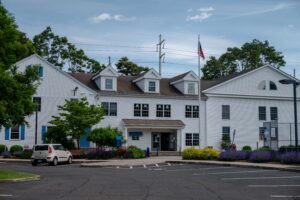Fairfield continues to fight transmission towers on multiple fronts

When Bill Gerber spoke to Westfair about his top priorities shortly after taking office as Fairfield’s First Selectman in Jan 2024, he listed the fight against United Illuminating (UI)’s proposed power transmission as one of his chief concerns.
Thus far he has made good on that promise, joining with local organizations such as the Saco Creek Neighbors Environmental Trust Inc. (SCNETI) to mount an opposition that has included both legal and legislative efforts to oppose the construction of the transmission lines. They are attempting to pressure UI into switching to buried transmission cables, which the company claims would be prohibitively expensive.
Gerber, appearing at a May 30 townhall meeting in a SCENTI T-shirt reading “It’s U & I vs. UI” began by discussing a recent meeting with UI.
“One of the big topics of conversations was an article in the New York Times as well as New York Magazine about an awakening towards new technology,” Gerber said, referring to an April article which discussed both the emergence of new materials for electrical transmission and why adoption has been slow.
“The resistance to that by utility companies [was] because they didn’t get to spend the money on their assets and get their guaranteed return,” Gerber said. “In fact, it seemed like for them it is too cheap to make the money that they would like.”
Resistance from the municipal side has taken several tacks. Steve Stafstrom, the Connecticut Representative for the section of Bridgeport impacted by the construction discussed how House Bill 5507, which allows for earlier intervention by parties to decisions by the Siting Council had passed through the legislature and was only waiting for Governor Ned Lamont’s signature to become law.
“This bill is about several things,” Stafstrom said. “First it’s trying to eliminate some of the perception, or as we believe, the reality, that the Siting Council has gotten far too cozy with utilities, and how do we level the playing field.”
Phil Pires, the attorney for the Town of Fairfield told the town hall that little had changed since the administrative appeal filed in Superior Court the previous month. He did note that starting June 21 Fairfield and other appellants will be able to file briefs with the court, which will start a long legal process.
“We have our hearing before the judge on January 13, 2025” Pires said, noting that the oral arguments before the judge were distinct from a trial. “The judge would then have four months to make a decision.”
When United Illuminating Manager of Transmission Lines Shawn Crosbie spoke to Westfair on the matter in April he indicated that the string of 102 monopoles across 7.2 miles of land was the best balance between environmental concerns, ease of maintenance, and cost to both ratepayers and shareholders. Crosbie also noted that the lines were deemed necessary by other entities.
“We have to install to meet the design requirements of the [National Electric Safet Code] and our Avangrid design requirements to account for certain climate change considerations and wind and load capacities,” said Crosbie. “Those catenaries could not withstand that. And we worked with Connecticut DOT, and they would not allow [using the catenaries] as an alternative performed by United Illuminating.”
Numerous organizations and entities are involved in the process, even before construction starts.
Asked for comment about the project and its necessity, Connecticut Public Utilities Regulatory Authority (PURA) Director of Legislation, Regulations and Communications Taren O’Connor noted that PURA only has regulatory authority over the construction itself and the operation of facilities. ISO New England, the not-for-profit corporation that overseas the region’s energy grid and electricity markets has two committees involved in making decisions regarding the projects while the Siting Council makes specific calls.
Meanwhile the Federal Energy Regulatory Commission is in charge of setting the overall costs of the infrastructure project.

Originally, the lines were slated to travel along the south side of the Metro North Rail line which passes through Fairfield and part of Bridgeport, providing infrastructure for grid scale power transmission currently carried along older towers immediately above the rail line.
The southside of the tracks would have required significant easements and encroached on historic buildings such as the Pequot Library.
However, the Connecticut Siting Council opted to move the project to the north side of the track, avoiding some impacted properties and structures but passing close to an entirely different set of homes, businesses, and local institutions. Just across the tracks from the Pequot Library is the Wakeman Boys and Girl’s Club, which sits close to the tracks.
The move to the north side of the tracks has been frustrating for both sides. UI has indicated that it will need many months to fully develop an engineering plan before providing insight into the specific siting of installed poles, as well as what the easements will specifically entail.
Meanwhile, SCNETI members and other Fairfield residents are left even more uncertain about what the future will entail.